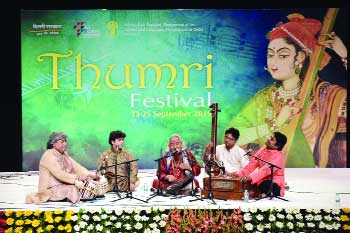While experts say that Thumri is popular because of its rhythm and words, which are easy for the audience to comprehend unlike other classical music forms, semi-classical vocalist Dhanashree Pandit Rai attributed its appeal to poetry. By Sakshi Sharma
Low chants of alaap sprung from afar and the aroma of fresh marigold flowers and itr wafted their way into my senses as I climbed the auditorium’s steps. The fragrance and the swift notes of the tabla grew stronger as I stepped towards the stage to have a clearer view. Every beat of the tabla seemed to be soothing as its ragas synchronised with the sitar aptly. The hall, packed with the audience, saw people sitting even on the floors. They shook their heads to and fro as they lost themselves in the transcendence of music. And why wouldn’t they? It was the renowned classical vocalist Pandit Channulal Mishra from Varanasi, performing at the third day of the ninth edition of the Thumri Festival, which had me sinking in its warmth and joy.
The Khayal, Dadra, Thumri, Chaiti, Kajri, Sawani, Holi and Bhajan expert could barely walk and entered the stage with the help of a few people. His grey hair and lines on the forehead made evident of the years he has invested as an artist. However, his enthusiasm even in his 90s looked amusing. The pin-drop silence broke when he began singing his piece. Not a single soul hummed along as they stared at him solemnly, in awe. The songs had an air of playful persuasion with notes delicately merging into one another. The harmonium, sitar and tabla were perfectly put to amalgamation. He kept asking the audience for their choice of songs and sang accordingly. As he was about to complete his last piece, the audience unanimously asked for more. He grinned like a Cheshire cat and said, “You are not letting me stop, and even I don’t wish to.” As he added, “Jaha husn ki tareef ho, chahne waale bhi wahin rukte hai.” The auditorium echoed with claps from every corner. He kept the viewers hooked till the end, wanting for more.
The evening also witnessed the performance of semi-classical vocalist Dhanashree Pandit Rai. Her repertoire spans classical Khayal, Thumri, Ghazal, Bhajan. However, Thumri remains her speciality. Explaining the concept, she said, “It originated from the word thum, which implies, the sound of ghungroo. And ri means rijhana or to please. Thumri emerged from the court of Nawab Wajid Ali Shah at the end of the 18th century and the beginning of the 19th century.” It initially aimed to entertain the nawabs and accompanied Kathak. She added, “It was sung by the courtesans for seduction. It later evolved into a semi-classical form in the Mughal courts.” She explained its positioning as a semi-classical art, which is between hardcore classical, khayal gayaki and the light music, which includes ghazals. Traversing its journey over the years, she said, “It has travelled from the brothels to the concert stage and is respected more today.”
While experts say that the reason for its popularity are its rhythm and words, which are easy for the audience to comprehend unlike other classical music forms, Dhanashree attributed its popularity to the poetry associated to it. She said, “Just like in ghazals, poetry dominates, but the whole appeal of Thumri comes from bhav. Emotions play a vital role in any art form. You have to put your heart and soul in it. And in Thumri, you can express one line in five different ways, that’s where the beauty lies.”
Today, on one hand, people are either preferring hip-hop or suiting up with the rap culture or on the other, choosing classical music. There is no in-between as they have been lost. For Dhanashree, Thumri is a combination of both modernity and traditionality due to its semi-classical element. She said, “It should actually be ruling the roost since it seamlessly blends the two. And today, the youth is also taking more interest. Now with the help of such festivals, which aim to popularise such art forms, it is grabbing more eyeballs.” There are many Bollywood songs which have also been adopted from this form of music like Hamari Atariya (Dedh Ishqiya), Aaoge Jab Tum (Jab We Met), Mora Peeya (Rajneeti) and others. These songs have been a major hit.
She believes that, despite new and peppy genres coming to the fore, classical music will always have a niche audience. She said, “It will continue to grow. The future of our traditions and rich heritage is bright. We just need more workshops and festivals to recognise and appreciate our glory.”
The evening also saw a soulful performance by Pandit Rajendra Sijuar, who represents the Gaya Gharana, which is generally known for its Purabang Thumri style Gayaki specialised in Bol Banao Thumri. As he started singing Mad Ke Bhare Tore Nain, people started humming on his notes. It was followed by Desh Saiyan Bulaave Aadhiraat.
The first and second day of the festival also witnessed mesmerising performances by eminent artists. Deputy CM Manish Sisodia was also present at the festival. He said, “The enthusiasm of the audience to attend such musical event is a sign that our effort to promote the Hindustani classical music is paying off. Culture is the best way to send the message of harmony and brotherhood to the people because we have a rich classical music culture.”


























